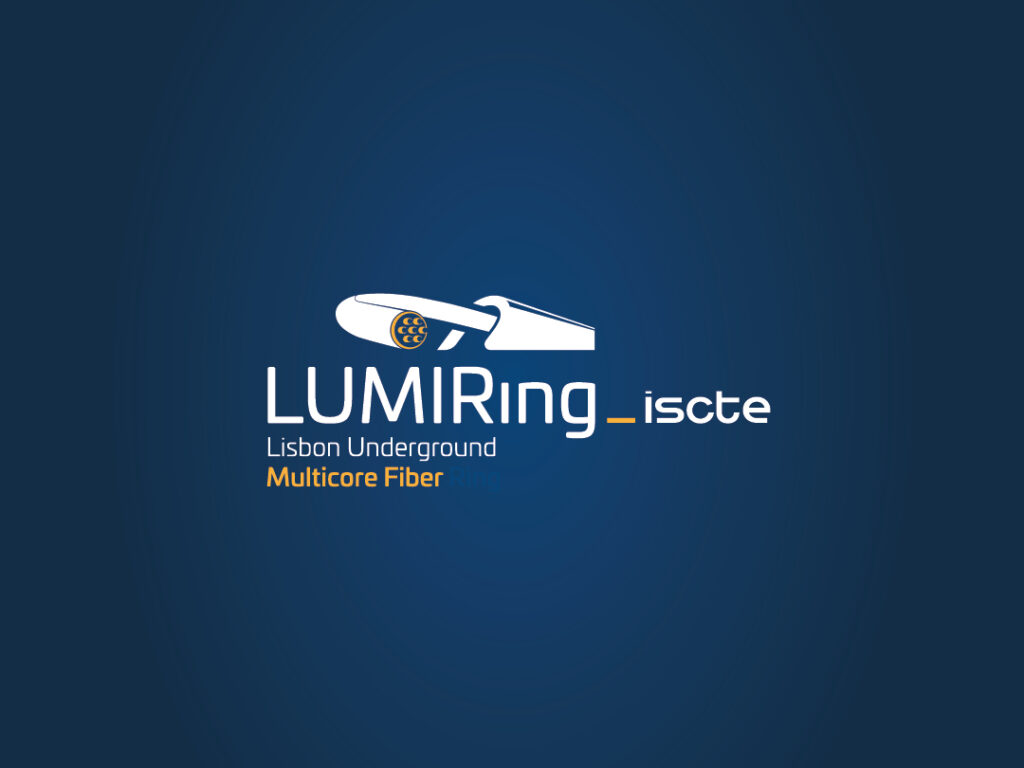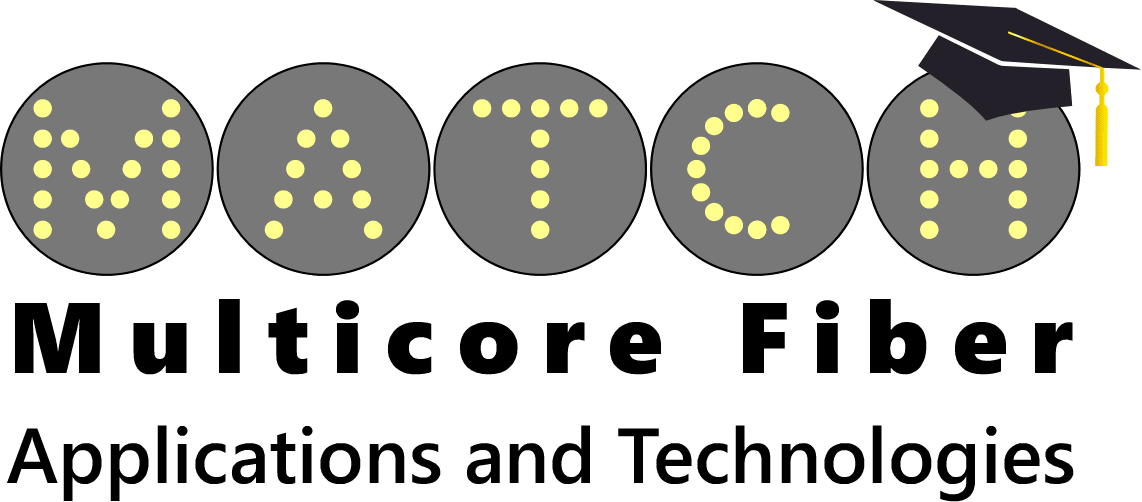MULTI-CORE FIBRE TEST-BED ON THE YELLOW LINE OF THE LISBON UNDERGROUND
Global Coordinator
The LUMIRing project aims to deploy a multi-core fiber (MCF) test bed within Lisbon Metro’s Yellow Line — an ambitious and groundbreaking initiative to explore weakly coupled MCF transmission under real-world conditions. By leveraging the harsh mechanical stresses caused by metro operations in underground tunnels, the project offers a unique opportunity to investigate and address real-life transmission challenges.A core goal is to design, implement, and validate advanced techniques that both mitigate performance degradation and enable the integration of data transmission with sensing, pushing the limits of current MCF capabilities.The test bed’s main infrastructure includes a 12-tube cable, with each tube containing 12 fibers. The cable contains 74 standard cladding diameter WC-MCFs (of 5 different types, with 4 and 7 cores and with step and trench-assisted refractive index profiles) and 70 conventional single-mode single-core fibers (SSMF).
Project Information
2025-04-01
2028-06-30
Project Partners
- IT-Iscte (OCPG) - Leader
- Heraus - (Germany)
- Metro Lisboa - (Portugal)
- Tratos - (Italy)
Multicore Fiber Applications and Technology
Global Coordinator
Multicore fiber Applications and TeCHnologies (MATCH) is a doctoral training network funded by the European Commission, under the MSCA Doctoral Networks 2023 | Marie Skłodowska-Curie Actions, and proposed by a multidisciplinary and intersectoral consortium of international experts.
- MATCH directs PhD research toward multicore fibre (MCF) technology;
- MATCH aims at developing leading solution for scaling future optical fibre communication networks towards emerging information capacities, while offering the potential to lower costs, reduce power consumption and significantly boost network capacity by over tenfold;
- MATCH programme outlines a comprehensive set of research and training objectives tailored to 13 doctoral candidates (DCs);
-The cohort of DCs will be hosted by 14 partners (10 from academia and 4 from the industrial sector);
- The planned training activities of DCs include 32 secondments, 7 mini-symposiums, 3 transferable skills workshops, summer schools, and tutorials, among others.
In MATCH program, DCs will acquire expertise in diverse areas, encompassing:
(i) Design and fabrication of MCFs with transmission capacities surpassing the state-of-the-art;
(ii) Design and implementation of MCF components and subsystems, with a focus on optical amplifiers and switches, multiple frequency comb sources, and parallel-scalable signal processing architectures;
(iii) Development and implementation of machine learning techniques for end-to-end performance optimization of MCF networks;
(iv) Design and evaluation of coexistence of telecom and non-telecom signals in MCF networks.
By engaging the expertise of MATCH academic and industrial partners, DCs will acquire distinct skills and knowledge to transform them to globally-minded scientists and engineers, who will help to shape Europe’s ICT future and societal wellbeing.
For more information see: https://match.iscte-iul.pt/
Project Information
2025-01-01
2028-12-31
Project Partners
- IT-Iscte (OCPG) - Leader
- UNILIM - (France)
- UPVLC - (Spain)
- IT - (Portugal)
- HCV - (Germany)
- INF - (Portugal)
- UST - (Germany)
- CNRS-PhLAM - (France)
- HUJI - (Israel)
- DTU - (Denmark)
- UNIVAQ - Associated Partner (Italy)
- FBGS - Associated Partner (Belgium)
- DRA - Associated Partner (France)
- ULille - Associated Partner (France)
Digital Compensation of Inter Crosstalk in Multicore Fibers
Local Coordinator
The ultimate goal of the project comprises the development, implementation and experimental validation of low-complexity data-center-network-compatible digital mitigation techniques for effective reduction of the outage constraints imposed by inter-core crosstalk (ICXT) in weakly-coupled MCF-based systems.
Utilização de Tecnologias de Reflectometría no melhoramento do futuro Internet das Coisas e Sistemas Ciber-Físicos
Local Coordinator
Main Objective: RETIOT aims to create a new competence area in Portugal on Reflectometry Technologies applied to the future Internet of Things and Cyber-Physical Systems based on a multidisciplinary research including optics, radio and autonomous systems.
Analysis and Mitigation of crosstalk Effects in multicore fibre -based Networks
Global Coordinator
This project aims at developing and analysing models for the statistical characterisation of ICXT in MCFs, proposing techniques for mitigating those effects in MCF-based networks, and using those achievements in the development of ICXT-aware algorithms for routing, spectrum and core assignment (RSCA) in MCF-based elastic optical networks (EONs). The project focuses on the theoretical and simulation studies of the statistical characteristics of ICXT in MCF and techniques for mitigating its impact on MCF-based networks. These studies are complemented by the experimental demonstration of the main outcomes of the theoretical and simulation studies. The project takes advantage of the expertise on experimental work and system design on MCF technology of NICT (National Institute of Information and Communications Technology, from Japan) combined with the experience of IT (Optical Communications Group at Lisbon site of Instituto de Telecomunicações) on theoretical modelling and analysis of optical fibre telecommunication systems and networks.
Project Information
2016-04-01
2018-12-31
Project Partners
Metro Networks Based on Multi-Band Orthogonal Frequency-Division Multiplexing Signals
Global Coordinator
The general objective of this project consists in demonstrating the new paradigm related to the increase of the flexibility and granularity of the transmission capacity in metropolitan (metro) optical networks. Particularly, the implementation of metro networks based on high data-rate multi-band orthogonal frequency-division multiplexing signals employing wavelength division multiplexing (WDM) is analysed and demonstrated as an excellent solution to provide, simultaneously, high flexibility in capacity allocation, high spectral efficiency and the possibility of upgrading the network capacity while keeping the system architecture almost unchanged.
Project Information
2013-04-01
2015-09-30
Project Partners
Fully-Converged Quintuple-Play Integrated Optical-Wireless Access Architectures
Local Coordinator
FIVER project proposes and develops a novel integrated access network architecture employing only OFDM signals for the provision of quintuple-play services (Internet, phone/voice, HDTV, wireless WiMAX, UWB and LTE femtocell and home security/control). FIVER architecture is completely integrated: The optical access FTTH, the in-home optical distribution network and the final radio link become part of the access. This permits a streamlined network architecture avoiding most of the conversion stages and proving cost, space and energy savings. FIVER is a fully OFDM-based network. This permits a cost-effective, fully centralised network architecture where the transmission impairments (both optical and radio) compensation and network management is done only at the Central Office. No further compensation, regeneration or format conversion is required along the network giving the streamlined network architecture capable of handling future services of interest. FIVER services are fully converged: Both OFDM data (Gigabit-Ethernet provision) and standard wireless (WiMAX, UWB, LTE and DVB-T) signals are transmitted in radio-over-fibre through the FTTH, the inbuilding optical infrastructure and also the final user radio link. The use of full-standard wireless signals for optical and radio transmission gives two advantages: Fully standard receiver equipment can be used by the customer, and no ad hoc detection, remodulation or frequency conversion is required. All the transmission compensation algorithms, electro-optical subsystems and network management are developed by FIVER consortium. FIVER architecture is future-proof. The project demonstrates HDTV service provision in the 60 GHz radio band at the last stage. Other wireless services operation in other bands can be included in the FIVER network architecture as long as they are OFDM-based. This is due to the powerful transmission impairment compensation algorithms developed in the project. FIVER-ENLARGED EU initiative brings l...
Project Information
2010-01-01
2012-12-31
Project Partners
- IT-Iscte
- UPVLC - Leader (Spain)
- PTIN - (Portugal)
- Corning - (France)
- University of Essex - (United Kingdom)
- THALES - (France)
- HTW-DRESDEN - (Germany)
- EIT+ - (Poland)
- DAS - (Spain)
- FIBERNOVA SYSTEMS - (Spain)
- TOWERCOM - (Slovakia)
Ultra-wide band real-time interference monitoring and CELLular management Strategies
Local Coordinator
Project Information
2008-01-01
2010-12-31
Project Partners
- IT-Iscte
- WISAIR LTD - (Israel)
- UPVLC - Leader (Spain)
- Agilent - (Belgium)
- DAS - (Spain)
- KUL - (Belgium)
- IMST - (Germany)
- PHOTLINE TECHNOLOGIES - (France)
- SIRADEL - (France)
e-Photon/ONe + – Optical Networks:Towards Bandwidth Manageability and Cost Efficiency
Local Coordinator
Project Information
2006-03-01
2008-02-29
Project Partners
Project Information
2004-03-01
2006-03-01
Project Partners
Broadcasting and Multicasting Over Enhanced UMTS Mobile Broadband Networks
Local Coordinator
B-BONE main objective is to further enhance UMTS capacity, transmission rates, RAN and Core network functionalities, considering both FDD and TDD modes, so as to accommodate digital broadcasting/multicasting (multimedia) type services.

 Português
Português




